Intel Core i7-10700 vs Core i7-10700K Review: Is 65W Comet Lake an Option?
by Dr. Ian Cutress on January 21, 2021 10:30 AM EST- Posted in
- CPUs
- Intel
- Core i7
- Z490
- 10th Gen Core
- Comet Lake
- i7-10700K
- i7-10700
CPU Tests: Simulation
Simulation and Science have a lot of overlap in the benchmarking world, however for this distinction we’re separating into two segments mostly based on the utility of the resulting data. The benchmarks that fall under Science have a distinct use for the data they output – in our Simulation section, these act more like synthetics but at some level are still trying to simulate a given environment.
DigiCortex v1.35: link
DigiCortex is a pet project for the visualization of neuron and synapse activity in the brain. The software comes with a variety of benchmark modes, and we take the small benchmark which runs a 32k neuron/1.8B synapse simulation, similar to a small slug.
The results on the output are given as a fraction of whether the system can simulate in real-time, so anything above a value of one is suitable for real-time work. The benchmark offers a 'no firing synapse' mode, which in essence detects DRAM and bus speed, however we take the firing mode which adds CPU work with every firing.
The software originally shipped with a benchmark that recorded the first few cycles and output a result. So while fast multi-threaded processors this made the benchmark last less than a few seconds, slow dual-core processors could be running for almost an hour. There is also the issue of DigiCortex starting with a base neuron/synapse map in ‘off mode’, giving a high result in the first few cycles as none of the nodes are currently active. We found that the performance settles down into a steady state after a while (when the model is actively in use), so we asked the author to allow for a ‘warm-up’ phase and for the benchmark to be the average over a second sample time.
For our test, we give the benchmark 20000 cycles to warm up and then take the data over the next 10000 cycles seconds for the test – on a modern processor this takes 30 seconds and 150 seconds respectively. This is then repeated a minimum of 10 times, with the first three results rejected. Results are shown as a multiple of real-time calculation.
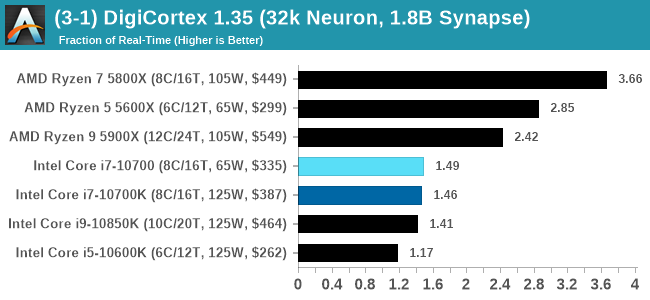
For users wondering why the 5800X wins, it seems that Digicortex prefers single chiplet designs, and the more cores the better. On the Intel side, the 10700 pulls a slight lead.
Dwarf Fortress 0.44.12: Link
Another long standing request for our benchmark suite has been Dwarf Fortress, a popular management/roguelike indie video game, first launched in 2006 and still being regularly updated today, aiming for a Steam launch sometime in the future.
Emulating the ASCII interfaces of old, this title is a rather complex beast, which can generate environments subject to millennia of rule, famous faces, peasants, and key historical figures and events. The further you get into the game, depending on the size of the world, the slower it becomes as it has to simulate more famous people, more world events, and the natural way that humanoid creatures take over an environment. Like some kind of virus.
For our test we’re using DFMark. DFMark is a benchmark built by vorsgren on the Bay12Forums that gives two different modes built on DFHack: world generation and embark. These tests can be configured, but range anywhere from 3 minutes to several hours. After analyzing the test, we ended up going for three different world generation sizes:
- Small, a 65x65 world with 250 years, 10 civilizations and 4 megabeasts
- Medium, a 127x127 world with 550 years, 10 civilizations and 4 megabeasts
- Large, a 257x257 world with 550 years, 40 civilizations and 10 megabeasts
DFMark outputs the time to run any given test, so this is what we use for the output. We loop the small test for as many times possible in 10 minutes, the medium test for as many times in 30 minutes, and the large test for as many times in an hour.
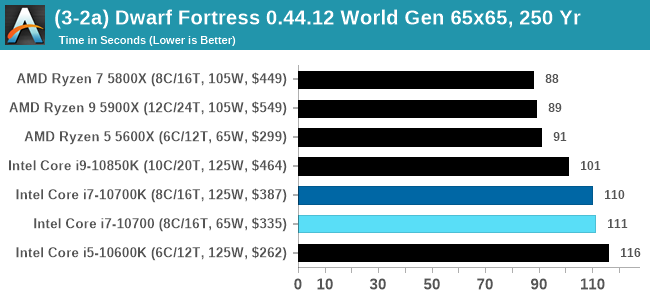
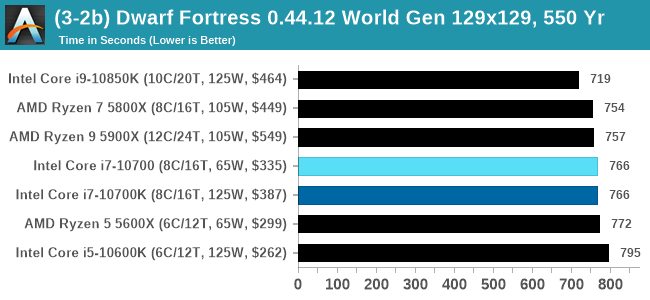
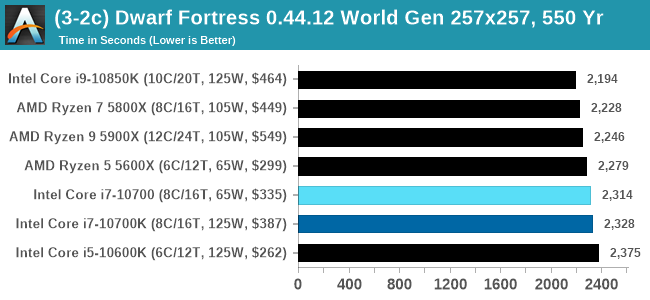
Dolphin v5.0 Emulation: Link
Many emulators are often bound by single thread CPU performance, and general reports tended to suggest that Haswell provided a significant boost to emulator performance. This benchmark runs a Wii program that ray traces a complex 3D scene inside the Dolphin Wii emulator. Performance on this benchmark is a good proxy of the speed of Dolphin CPU emulation, which is an intensive single core task using most aspects of a CPU. Results are given in seconds, where the Wii itself scores 1051 seconds.
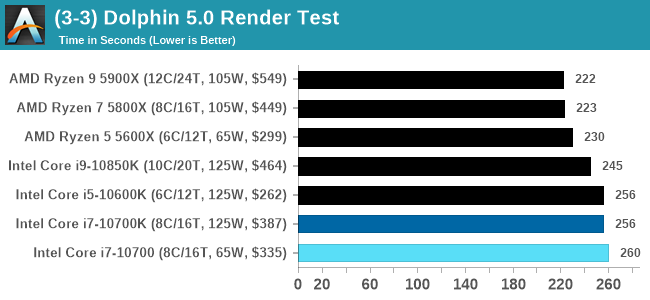












210 Comments
View All Comments
magreen - Friday, January 22, 2021 - link
Man Spunji, you are diligent. I was just going to ignore the obvious trollSpunjji - Monday, January 25, 2021 - link
It's a sensible policy - I just like debunking FUD 👍bji - Thursday, January 21, 2021 - link
Ryzen 5 5600x at $299 is a lie right now than and has been for months. It's slowly coming down to $399 with general availability. It will be months before it's actually available at $299.Please no one respond with stories of one-off deals that they happened to get from some rare and hard to find vendor, where the deal was only available for 10 minutes anyway.
The simple fact is that no Ryzen 3 processors have had general availability at anywhere near MSRP for months.
Golgatha777 - Thursday, January 21, 2021 - link
I've personally purchased 2 5600X and 1 5800X for MSRP at Micro Center?bji - Thursday, January 21, 2021 - link
Micro Center is not "general availability" given that it's only accessible to a few million people who happen to be within driving distance of one of their stores so, you fail.silverblue - Thursday, January 21, 2021 - link
Well... one stockist (OCUK) in the UK has had the 5600X at £279 for at least the past 24 hours, whereas the average on Google seems to be about £310 to £320. Your mileage may obviously vary, I suppose.bji - Thursday, January 21, 2021 - link
The US MSRP is $299 which is 218 British Pounds. So the numbers you quote indicate a significant reseller mark-up which makes my point. So thanks for agreeing with me.I wouldn't mind paying AMD a fair price ($399 apparently) for a 5600X, but I will NOT give $100 or more to scalpers. AMD will use my money to make me more of what I want (faster chips). Scalpers will use my money to just scalp me harder in the future. I will never buy a scalped product.
And so I continue to wait and wait to build a 5600X/RTX3080 gaming PC ... been waiting for months now ...
Calin - Friday, January 22, 2021 - link
I think the UK price indicate about 20% of Value Added Tax - which is paid directly at the moment of sale. If I remember correctly, US prices do not contain "State Tax" and the like.silverblue - Sunday, January 24, 2021 - link
Exactly. Aside of any delivery costs from retailer to customer, we pay what's written on the price tag. That $299 isn't looking so cheap now. Funnily, the current conversion from dollars to pounds means a near 1:1 for comparison.jimbo2779 - Friday, January 22, 2021 - link
Everything is more expensive in the UK. Our MSRP is different to yours because of import duties. MSRP is still MSRP just that our MSRP is different from your MSRP.We would not be expecting to be paying US pricing just as we wouldn't expect to pay the going rate in Australia, that is the case for every saleable item.